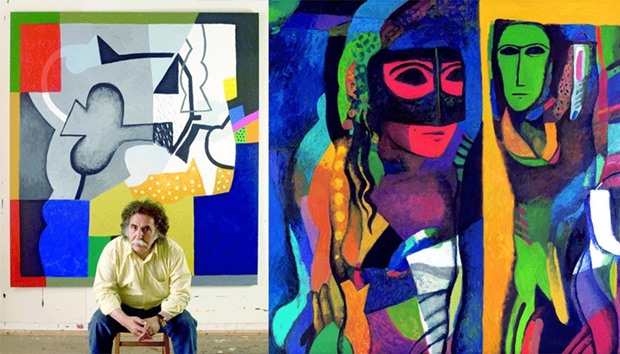At the IDAM restaurant, gloriously flooded with natural light on the top floor of the Museum of Islamic Art, Qatar Museums (QM) yesterday noon presented its autumn programme buzzing with a series of promising upcoming events, crowning which is the sweeping Dia al-Azzawi retrospective that chronicles the art and life of one of Iraq’s most influential living artists.
Internationally recognised as one of the pioneers of modern Arab art, al-Azzawi’s masterful work is set to take Doha by storm when his exhibition, split between two venues, will open on October 16 and 17 at Mathaf: Arab Museum of Modern Art and QM Gallery Al Riwaq, respectively. Billed as the biggest exhibition of the artist’s work to date, the exhibition will run until April 16, 2017. Titled “I am the cry, who will give voice to me? Dia Al-Azzawi: A Retrospective (from 1963 until tomorrow)”, the exhibition is curated by Catherine David.
Namkha Beschi, curator at Mathaf who is assisting David in the exhibition, told Community, “An exhibition of this nature is unprecedented. The retrospective presents the first historical monograph of artist Dia al-Azzawi, a major modern artist of the Arab world. Dia’s work is one of our permanent collections. This is unprecedented also because we are talking about showing 521 artworks in a range of media. So logistically, technically, and also working with Catherine David as a curator who’s bringing her own vision to the show, is quite an amazing experience.”
It was 40 years ago that al-Azzawi moved to the UK. It’s from London that he continued to draw inspiration from his nation, understand the Iraqi and Arabic culture better, and pour it all into his art that covers a range of subjects executed in a variety of media including painting, sculpture, prints, drawings, and book art.
“The most challenging aspect is the fact that the exhibition is split in two locations,” Beschi further explained, “From a curatorial perspective, I think it’s our job to make sure that there is a continuity between the two locations. Being a retrospective, somehow chronological, it has a thread to it. While Mathaf would be more focussed on his technique and his practice as an artist, the Al Riwaq part is more focussed on his relations to politics and how political events affected and influenced his work and his practice.”
Tracing a trajectory of the artist’s practice, the exhibition “maps an itinerary of modernism across which history is recuperated and transfigured into means for giving form to modern life,” said Beschi, earlier in her speech at the event.
The first part of the exhibition at Mathaf begins with a survey of the artist’s early engagement with historical and popular sources, in order to trace the consequences of his encounters with Arab poets, among them Mahmoud Darwish, Fadhil al-Azzawi, Saadi Youssef and Muzaffar al-Nawab, Beschi pointed out. “The exhibition goes on to chart the shifts that occur in his practice, in relation to the techniques of printmaking, and finally the consolidation of the relation between image and text into the daftar, a personal interpretation of the artist book form developed throughout the 20th century,” she said.
At Al Riwaq, the second part of the exhibition profiles the relation between art and politics that emerged in al-Azzawi’s practice after 1968. “It traces the formation of his critical use of the human form, in response to the collapse of the Palestinian liberation movement (1970) and the artist’s experience during his last service in 1973 on the Kurdistan war front. This posture was reactivated after a period of withdrawal following the artist’s move to London, in response to the Gulf war in 1991 and to the American invasion of 2003,” Beschi elaborated in her speech.
The retrospective will course through art of all scales and media including painting, sculpture, drawing, print and artist books, “incorporating original and limited editions of artworks on view for the first time.” Al-Azzawi’s work is held in international private and public collections across the world.
Beschi finds it interesting that al-Azzawi’s works that are usually shown are his later and his latest works and they are not necessarily representative of his body of works in general. “I think what this retrospective does is show the different periods and the transitions that he went through. For instance, one of the periods when he was in London, in the 1970s, there was a whole series of paintings that he made that is really unique and completely different from what we know of his work, which is very colourful and vibrant. So it’s a different aspect of his work that hasn’t been shown until now,” she said.
Al-Azzawi has had a long association with QM, featuring in the opening exhibition of Mathaf Arab Museum of Modern Art and QM Al Riwaq in 2010.

Dia al-Azzawi. Right: A piece by al-Azzawi, titled Majnoun Layla no. 2 (Temptation, 1995).
